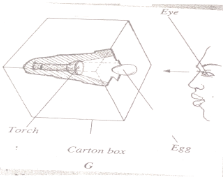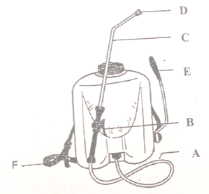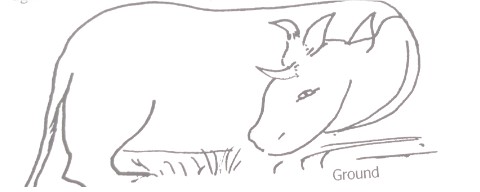SECTION A (30Marks)
Answer ALL questions from this section
- Name the exoticbreed of cattle producing milk with highest butter fat content. (½ mk)
- Give four reasons for identification in cattle management.(2mks)
- State four bacterial diseases affecting cattle. (2mks)
- Give four harmful effects of parasites in livestock. (2mks)
- Highlight four functions of vitamins in animals (2mks)
- State the gestation period of: (1mk)
- Ewe
- Sow
- State three methods of selection in breeding (1 ½mks)
- Give four qualities of a good vaccine. (2mks)
- State any four signs that a sow would show before farrowing. (2mks)
- What is cropping in aquaculture? (½mk)
- State any four uses of a crush (2mks)
- Differentiate between flushing and steaming up as used in livestock production. (1mk)
- State four conditions necessary for incubation (2mks)
- List three methods of extracting honey from the honey combs (1 ½ marks)
- List four reasons for docking in sheep. (2mks)
- State four advantages of keeping animals healthy (2mks)
- Mention four disadvantages of natural mating as a method of breeding in dairy cattle (2mks)
- Name any four breeds of dairy goats (2mks)
SECTION B (20 MARKS)
Answer ALL questions in this section in the spaces
- The diagram below illustrates an activity carried out by a poultry farmer keeping layers. Study it carefully and answer the questions that follow
- Name the activity illustrated above (1mk)
- Give four abnormalities in the eggs that can be detected during the above activity (4mks)
- State one function of the carton box in the activity illustrated above (1mk)
- Below is a diagram of knapsack sprayer. Study it carefully and answer the questions that foll
- Name the parts labeled B and D (2mks)
- State one main maintenance practice that should be carried out on the knapsack sprayer (1mk)
- State the function of the part labeled E and F (2mks)
- The diagram below shows parts of a plunge dip. Study the diagram and answer the questions that follow.
- Name the parts labeled A,B, and D (3mks)
- Give one reason why cattle are held for some time in part labeled C (1mks)
- State two maintenance practices carried out on part D (2mks)
- The following diagram illustrates a disease symptom in cattle. Study it carefully and answer the questions that follow.
- State the name of the disease (1 mk)
- State two other causes of the disease mentioned above (2mks)
SECTION C (40 MARKS)
Answer any TWO questions from this section
-
- Describe five factors to consider when selecting a breeding stock. (10mks)
- Describe five control measures of diseases in livestock and give an example of a disease controlled by the measure.
(10 mks)
-
- Discuss mastitis disease under the following
- Causal organism. (1mk)
- Symptoms (3mks)
- Causes of the disease (4mks)
- Control measures (2mks)
- State and explain the various factors that should be considered when siting farm structures (10mks)
- Discuss mastitis disease under the following
-
- Outline five factors considered when buying farm tools equipment to use (5mks)
- Explain five predisposing factors of livestock diseases (5mks)
- Explain factors a farmer should consider when selecting building materials for farm structures. (10mks)
MARKING SCHEME
SECTION A (30Marks)
- Name the exotic breed of cattle producing milk with highest butter fat content. (½ mk)
- Jersey
- Give four reasons for identification in cattle management.(2mks)
- Easy to select animal for bleeding.
- Facilitates treatment of sick animals.
- Helps to cull poor performing animals.
- Helps in recording.
- Helps to detect loss or theft.
- State for bacterial diseases affecting cattle. (2mks)
- Anthrax
- Black quarter
- Brucellosis
- Foot rot
- Mastitis
- Give four harmful effects of parasites in livestock. (2mks)
- Causes anemia
- Deprive animal of food
- Injury/ damage caused to tissue.
- Transmit diseases
- Causes irritation
- Causes obstruction of internal organs.
- Highlight four functions of vitamins in animals (2mks)
- Promote growth
- Help in blood clotting
- Help in bone formation
- Muscular activity
- Prevent diseases in animals
- Act as organic catalysts
- State the gestation period of (1mk)
- Ewe – 150 days
- Sow – 113-117 days
- State three methods of selection in breeding (1 ½mks)
- Mass selection
- Progeny testing
- Contemporary comparison.
- Give four qualities of a good vaccine. (2mks)
- Should be good as natural immunity
- Long keeping life
- Easy to administer to the animal
- Have no side effects when inoculated
- Should be compatible with other vaccines
- A single dose gives lifelong immunity
- State any four signs that a sow would show before farrowing. (2mks)
- Restlessness
- Enlargement of vulva
- Slackening of pelvic muscles
- Loss of appetite
- Enlarged udder
- Sow builds a nest
- What is cropping in aquaculture? (½mk)
- Selective removal of marketable sized fish from fish pond.
- State any four uses of crush (2mks)
- Spraying
- Identification
- Vaccination
- Milking
- AI
- Dehorning etc
- Differentiate between flushing and steaming as used in livestock production. (1mk)
- Flushing is the practice of giving an animal high nutritive feed around serving time while steaming up is provision of extra high nutritive feed before parturition.
- State four conditions necessary for incubation (2mks)
- Temperature – 37°c – 39°c
- Fresh air/ well venerated
- Relative humidity 60 %
- Egg turning
- List three methods of extracting honey from the honey combs (1 ½ marks)
- Heat method
- Crushing and straining method
- Use of centrifugal extractor
- List four reasons for docking in sheep. (2mks)
- To facilitate easy mating during bleeding
- For even fat distribution in the body.
- To reduce blowfly infestation
- To avoid soiling of wool.
- State four advantages of keeping animals health (2mks)
- For longer productive health
- Enables animals to breed regularly
- Control spread of diseases
- Healthy animals are high yielding
- To produce high quality
- Mention four disadvantages of natural mating as a method of breeding in dairy cattle (2mks)
- Causes in breeding if the bull is not controlled.
- It is economical to keep the bull.
- There is risk of transmission of breeding diseases.
- A bull may cause physical injury to a cow.
- Only a few cows can be mated by a bull at a given time.
- Name any four breeds of dairy goats (2mks)
- Saanen
- Toggen burg
- Aglo-nubian
- Jamnapari
- British Alpine
- German Alpine
SECTION B (20 MARKS)
-
- Name the activity illustrated above (1mk)
- Egg candling
- Give four abnormalities in the eggs that can be detected during the above activity (4mks)
- Tiny/hair cracks on the egg shells
- Presence of double yolks
- Blood spot in an egg
- Excessively larger air space.
- State one function of the carton box in the activity illustrated above (1mk)
- Cartoon box provides a dark environment for clear visibility through the egg
- Name the activity illustrated above (1mk)
-
- Name the parts labeled B and D (2mks)
- B-Trigger
- D-nozzle
- State one main maintenance practice that should be carried out on the knapsack sprayer after every use (1mk)
- Wash thoroughly and after use.
- Unblock nozzle that are blocked
- State the function of the part labeled E and F (2mks)
- E - For pumping pressure into the knapsack sprayer.
- F- Aid in carrying the sprayer when spraying.
- Name the parts labeled B and D (2mks)
-
- Name the parts labelled A,B and D (3mks)
- A- Foot bath
- B - Dip tank/ plunge tank
- D - Dispersal yard/drying yard.
- Give one reason why cattle are held for some time in part labeled C (1mk)
- minimize wastage of accaricides
- Minimize pasture contamination.
- State two maintenance practices carried out on part D (2mks)
- Repair cracked walls and floors
- Replace expired dip wash
- Maintain level of dip wash
- Maintain the concentration of dip wash
- Clean dipping tank regularly
- Name the parts labelled A,B and D (3mks)
-
- Name of the disease (1 mk)
- Milk fever
- State two other causes of the disease mentioned above (2mks)
- Deficiency of calcium in the blood of a lactating cow
- High milk yielding cow where calcium replenishment is not done.
- Name of the disease (1 mk)
SECTION C (40 MARKS)
-
- Describe five factors to consider when selecting a breeding stock. (10mks)
- Production level
- Age
- Health
- Mothering ability
- Temperament
- Adaptability
- Body conformation
- Prolificacy
- Physical defects
- Describe five control measures of diseases in livestock and give an example of a disease controlled by the measure.
(10 mks)- Prophylactic drugs e.g. coccidiosis.
- Quarantine- foot and mouth, anthrax etc.
- Isolation – calf scours
- Culling/mass slaughter- foot and mouth, anthrax
- Vaccination- anthrax, black quarter
- Control of vectors- nagana, east coast fever
- Use of healthy breeding stock- brucellosis
- Proper nutrition – milk fever
- Proper housing- pneumonia
- Proper milking techniques- mastitis
- Drenching – ascariasis
- Spraying – east coast fever
- Keeping resistant animals- Zebus- East Coast Fever.
- Hoof trimming – foot rot.
- Describe five factors to consider when selecting a breeding stock. (10mks)
-
- Discuss mastitis disease under the following
- Causal organism. (1mk)
- streptococcus spp or staphylococcus spp.
- Symptoms (3mks)
- Blood/ pus in milk
- Swollen or inflamated udder
- Rise in body temperature
- Drop in milk production
- Pain in the udder or treats
- Milk has a salty taste
- Fine clots in milk
- Causes of the disease (4mks)
- Incomplete milking
- Low standards of hygiene
- Injury to the udder/teats
- Genetic factors
- Stress
- Control measures (2mks)
- Use of correct milking technique
- Use of a strip cup to detect infected cows
- Practice proper hygiene
- Vaccination
- Use of dry cow therapy
- Treat with antibiotics
- Cull susceptible cows.
- Causal organism. (1mk)
- various factors that should be considered when siting farm structures (10mks)
- Accessibility to the structure
- Type of soil
- Relationship with existing structures
- Government policy on building and construction
- Topography of the land or drainage
- Space for future expansion
- Position/direction of the sun/orientation
- Availability of social amenities
- Drainage of the area
- Farmers tastes and preferences
- Discuss mastitis disease under the following
-
- five factors considered when buying farm tools equipment to use (5mks)
- Purpose /use of the equipment
- Cost of the tool/equipment
- Quality of the tool/ equipment whether high or low
- Skill required in handling the tool/equipment i.e. whether the skill is there or not
- Capital availability/financial strength /purchasing power of the buyer
- The nature of work need to be done
- five predisposing factors of livestock diseases (5mks)
- sex of the animals
- age of the animal
- Colour of the animal
- Breed of the animal
- Poor sanitation/environment
- factors a farmer should consider when selecting building materials for farm structures. (10mks)
- Durability
- Cost of the material
- Maintenance required
- Design of the building
- Prevailing weather condition
- Strength of the material
- Availability of the materials
- Types of structure/ use of structure
- Skills required in using the materials
- Beauty or attractiveness of the material
- five factors considered when buying farm tools equipment to use (5mks)
Download Agriculture Paper 2 Questions and Answers - Form 3 Mid Term 3 Exams 2023.
Tap Here to Download for 50/-
Get on WhatsApp for 50/-
Why download?
- ✔ To read offline at any time.
- ✔ To Print at your convenience
- ✔ Share Easily with Friends / Students





